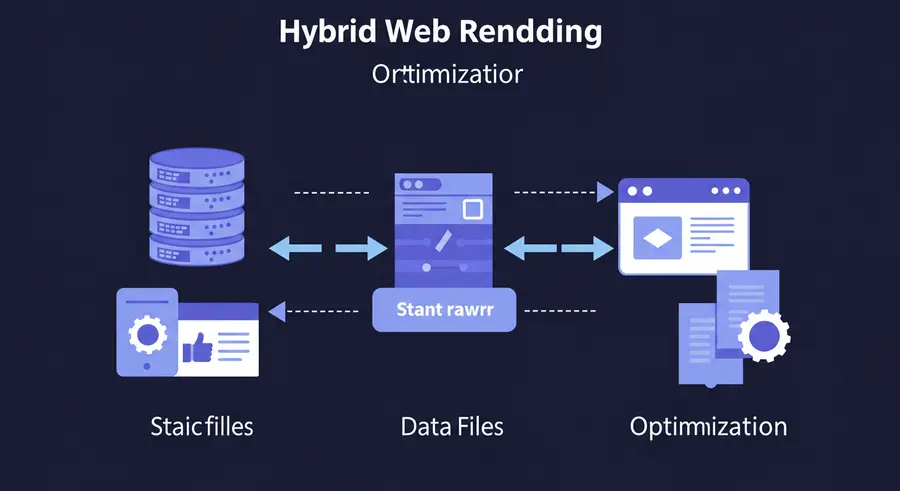Appearance

Welcome, web development enthusiasts! 👋 Today, we're diving deep into the fascinating world of web rendering, exploring how modern applications are moving beyond the traditional choices of Server-Side Rendering (SSR) and Client-Side Rendering (CSR) to embrace more powerful hybrid approaches.
For a foundational understanding of SSR and CSR, you can refer to our detailed article: Server-Side Rendering (SSR) vs. Client-Side Rendering (CSR)
The Evolution of Web Rendering
Historically, web pages were primarily rendered on the server (SSR), delivering a fully formed HTML document to the browser. Then came the rise of JavaScript and single-page applications (SPAs), leading to a shift towards Client-Side Rendering (CSR), where the browser takes on the heavy lifting of rendering the UI.
Both approaches have their strengths and weaknesses:
- SSR Benefits: Excellent for SEO, faster initial page load (Time to First Byte), and good for users with slower internet connections or less powerful devices.
- SSR Challenges: Can lead to higher server load, slower subsequent navigations (if not implemented carefully), and less interactivity compared to CSR.
- CSR Benefits: Highly interactive user experiences, rich dynamic content, and reduced server load after the initial page load.
- CSR Challenges: Can result in slower initial page load (larger JavaScript bundles), potential SEO issues (if not properly handled with pre-rendering), and reliance on client-side JavaScript execution.
Enter Hybrid Rendering: The Best of Both Worlds
Modern web development acknowledges that a "one-size-fits-all" rendering strategy is often not optimal. This is where hybrid rendering shines. It's about intelligently combining SSR, CSR, and even Static Site Generation (SSG) to leverage the strengths of each approach for different parts of your application.
Frameworks like Next.js, Nuxt.js, Remix, and Astro have popularized these hybrid models, giving developers the flexibility to choose the right rendering strategy on a page-by-page or even component-by-component basis.
Key Hybrid Rendering Strategies:
SSR with Hydration:
- The server renders the initial HTML for a page, providing a fast first paint and good SEO.
- Once the HTML arrives in the browser, JavaScript "hydrates" it, attaching event listeners and making the page interactive.
- This is a common pattern in frameworks like React (with
ReactDOMServer) and Vue (withVue Server Renderer). - Use Case: Ideal for content-heavy pages that also require interactivity, like e-commerce product pages or news articles with dynamic comments.
Static Site Generation (SSG) with Hydration:
- Pages are pre-rendered into static HTML, CSS, and JavaScript files at build time.
- These static files can be served very quickly from a CDN, offering excellent performance and security.
- Like SSR with hydration, JavaScript is then used on the client-side to make the page interactive.
- Use Case: Perfect for blogs, documentation sites, marketing pages, or any content that doesn't change frequently.
Incremental Static Regeneration (ISR):
- A powerful concept introduced by Next.js, ISR combines SSG with the ability to update static pages after they've been deployed.
- Instead of rebuilding the entire site for every content change, you can specify a revalidation period. When a request comes in for an outdated page, the cached version is served while a new version is generated in the background.
- Use Case: E-commerce sites with frequently changing product prices/stock, news sites with breaking updates, or any site where content needs to be fresh but still benefits from static serving.
Client-Side Rendering (CSR) for Dynamic Parts:
- Even within a mostly SSR or SSG application, certain components or sections might benefit from pure CSR.
- For example, a user dashboard with real-time data updates or an interactive game might be entirely client-rendered after the initial page load.
- Use Case: Highly interactive UIs, real-time dashboards, chat applications, or any component where SEO and initial load speed are less critical than immediate interactivity.
Why Hybrid Rendering Matters
- Optimized Performance: Deliver faster initial page loads and better perceived performance by serving pre-rendered content while enabling rich interactivity.
- Improved SEO: Ensure search engines can easily crawl and index your content, even for dynamic applications.
- Enhanced User Experience: Provide a smooth, responsive, and engaging experience for users, regardless of their device or network conditions.
- Reduced Server Load: Offload rendering work to the client or leverage CDNs for static assets, reducing the burden on your servers.
- Developer Flexibility: Choose the best rendering strategy for each specific use case, leading to more efficient and maintainable codebases.
Future Outlook
The trend towards hybrid rendering is only growing stronger. As web applications become more complex and user expectations for performance and interactivity rise, intelligent rendering strategies will be crucial. We'll likely see even more sophisticated techniques emerge, further blurring the lines between server and client rendering, all in pursuit of the ultimate user experience.
Embrace the hybrid approach, and unlock the full potential of your web applications! 🚀